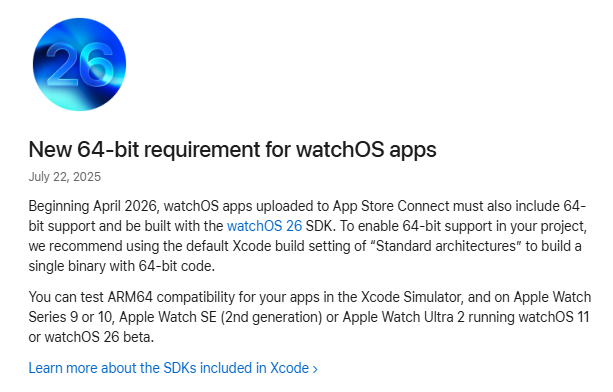
Loading...
Free consultation with ASO specialists
Doing ASO for the first time or have no idea how to carry out targeted optimization of your app?
We offer one-on-one customized services provided by app marketing specialists
Apple watchOS App New 64-bit Requirement Comprehensive Analysis: Developer Adaptation Guide and Future Trends
2025-07-29
July 22, 2025, Apple officially releasedThe new 64-bit requirement for watchOS apps, requires all new watchOS applications submitted to the App Store must natively support 64-bit architecture (ARM64), and gradually phase out compatibility with 32-bit architecture (ARM64_32). This policy marks the final implementation of Apple's full-platform ARM64 strategy, which will have a profound impact on developers and the user ecosystem. This article combines Apple's official documentation and industry dynamics to analyze from technical details, performance improvements, user experience and other dimensions, and provides specific adaptation suggestions for developers.

Policy Background and Industry Trends: The Strategic Significance of Apple's ARM64 Platform
-
The final battle of the unified platform architecture
Since the Mac product line switched to Apple Silicon (ARM64 architecture) in 2020, Apple has completed the full 64-bit transition of iOS, iPadOS, and tvOS. The architecture upgrade of watchOS is the last link for Apple to achieve a unified architecture for the entire device ecosystem. A unified architecture means that developers can provide services for devices such as iPhone, Mac, and Apple Watch based on the same code library, greatly reducing cross-platform development costs. For example, fitness applications can reuse algorithm logic from the iOS side and directly run high-precision motion tracking functions on Apple Watch.
-
Enhance ecological collaboration and technological foresight
The ARM64 architecture supports a larger memory addressing space (theoretically up to 16EB) and a more efficient instruction set, laying the foundation for future feature expansion of Apple Watch. For example, watchOS 26 has allowed developers to call ECG electrocardiogram sensors and body temperature monitoring data, which are high-precision computing tasks that require ARM64's computing power support. At the same time, the unified architecture enables developers to seamlessly reuse Apple-native frameworks such as Core ML and Metal, accelerating the implementation of cutting-edge technologies such as AI and AR in wearable devices.
-
Industry Standardization and Long-term Compatibility
Apple's policy is consistent with the global trend in the tech industry: Google, Microsoft and other manufacturers have all eliminated support for 32-bit applications. The popularity of ARM64 architecture will promote technological standardization in the wearable device industry and avoid fragmentation issues. Apple has clearly stated that future watchOS new features (such as more complex health monitoring algorithms) will only support ARM64 architecture, and developers who continue to use ARM64_32 will face the risk of limited functionality.
Technical Details and Migration Challenges: The Core Differences Between ARM64 and ARM64_32
Architecture Differences: Pointer Size and Memory Model
-
ARM64_32: Uses a 64-bit instruction set, but the pointer width is fixed at 32 bits (4 bytes), and the maximum memory addressing space is 4GB. This architecture is specifically designed for low-memory environments of wearable devices, and early Apple Watches (such as Series 8 and earlier models) all use this architecture.
-
ARM64: Complete 64-bit architecture, pointer width 64 bits (8 bytes), supports larger memory space and more efficient register access. For example, ARM64 provides 31 64-bit general-purpose registers (X0-X30), while ARM64_32 only supports 16 32-bit registers (R0-R15), which means that complex computing tasks are executed more efficiently on ARM64.
Common issues and solutions for developers who migrate
-
Register overflow and data type mismatch
-
Questions: Use in ARM64_32int(4 bytes) code to store pointers, which will overflow on ARM64 due to pointer expansion to 8 bytes. For example,int ptr = (int)[NSData bytes];It will cause a memory access error under ARM64.
-
Solutions:
-
Use NS IntegerOrintptr_t Alternative int Store pointers, ensuring data type and architecture alignment.
-
Enable Xcode's 64-bit compatibility check (Build Settings > Enable 64-Bit) to automatically detect potential issues.
-
-
Memory Adaptation and Layout Adjustment
-
Questions: Recursive algorithms that depend on stack memory in ARM64_32 may crash due to insufficient stack space. For example, the stack depth of a deep recursive function is 8MB under ARM64_32, while ARM64 can be extended to larger space, but the thread stack size must be manually adjusted.
-
Solutions:
- Usepthread_attr_setstacksizeDynamically set the thread stack size.
-
Use heap memory first (such asmalloc) Storing large data structures.
-
Compilation Errors and Architecture Configuration
-
Questions: Xcode generates binary files supporting ARM64_32 by default, and direct submission will cause review failure. For example, developers do not check in XcodeARM64Architecture, will receiveInvalid ArchitectureError.
-
Solutions:
-
In Xcode project settings, setArchitecturesSet asARM64, and removeARM64_32. Uselipo -infoCommand to verify binary architecture:lipo -info MyApp.app/MyAppShould outputARM64.
-

Performance Improvement and Function Expansion: The Practical Value of ARM64 Architecture
-
The Energy Efficiency Revolution of Fitness Algorithms
Take real-time heart rate variability (HRV) analysis as an example:
-
ARM64_32 Ratings: Processing 10 seconds of heart rate data takes about 80ms, and power consumption increases by 5%.
-
ARM64 Optimized: By using the ARM64's NEON vector instruction set, the processing time is shortened to 35ms and power consumption is reduced by 18%. A health application developer reported that after refactoring, the code volume increased by 15%, but the energy efficiency ratio increased by 22%, and the user's endurance experience was significantly improved.
-
Machine Learning Inference Breakthrough
ARM64 architecture support for the Core ML framework greatly improves model inference speed. For example:
-
Running the real-time motion posture recognition model (MobileNetV3) on Apple Watch Ultra 2, the inference delay under ARM64 is 120ms, which is 40% lower than that of ARM64_32. This allows developers to achieve more accurate swimming stroke analysis, running posture correction and other functions.
-
In the future, the ARM64 architecture will support more complex models, such as Transformer-based speech recognition, which cannot be implemented on ARM64_32 due to computing power limitations.
-
Future space for imagination of functional innovation
-
High-precision health monitoring: Combined with the temperature sensor and ARM64's floating-point operation capability, developers can develop professional applications such as ovulation prediction and disease warning.
-
Offline AI Interaction: Run a lightweight large language model (such as Llama 2 mini version) locally to achieve voice assistant functionality without the need for internet connectivity.
-
Augmented Reality (AR): Through ARM64's parallel computing capability, Apple Watch may support simple AR navigation (such as route arrows superimposed on the dial).
User and Developer Perspectives: A Dual Dimensional Analysis of Architecture Upgrades
User Experience Upgrade: A Double Leap in Performance and Functionality
-
A qualitative change in fluency and responsiveness
The instruction set optimization and register extension brought by the ARM64 architecture directly improve application running efficiency. Take fitness applications as an example, real-time heart rate variability (HRV) analysis requires 80ms to process 10 seconds of data under ARM64_32, while the ARM64 architecture shortens the time to 35ms through the NEON vector instruction set and reduces power consumption by 18%. User feedback shows that the background audio processing delay of music playback applications is reduced by 50%, and multi-task switching stuttering significantly decreases.
-
Breakthrough Expansion of Functional Boundaries
-
Health monitoring accuracy jumps: real-time analysis of ECG data (such as atrial fibrillation warning) can achieve higher sampling rates (from 250Hz to 500Hz) on ARM64 architecture. Combined with temperature sensor data, developers can develop professional applications such as ovulation prediction and early disease warning.
-
Local AI interaction: ARM64 architecture support on Apple Watch Ultra 2 to run lightweight large language models (such as Llama 2 mini version), achieving voice assistant functions without network connection, which cannot be completed on ARM64_32 devices due to computing power limitations.
-
Long-term Experience Guarantee
Apple has made it clear that future watchOS new features (such as the motion posture recognition model of watchOS 26) will only support the ARM64 architecture. Users who continue to use older devices may face the risk of missing features or performance degradation.

Developer Perspective: Rebalancing Migration Costs and Strategic Value
-
Short-term migration challenge
-
Dual architecture parallel development pressure: Developers need to configure ARM64 and ARM64_32 architectures simultaneously in Xcode, generating Universal Binary containing dual instruction sets. A developer of a health application said that pointer type checking and memory optimization alone consumed 25 man-hours, and testing on Series 9 (ARM64) and Series 8 (ARM64_32) devices separately extended the testing cycle by 20%.
-
Toolchain adaptation details:
-
Compilation option adjustment: Bitcode must be disabled (ARM64_32 does not support it), and enabled Build Active Architecture OnlyForNo, ensure that the complete binary file is generated.
-
Debugging Complexity: Use Instruments
When analyzing performance, it is necessary to verify on two types of architecture devices separately, avoiding the NEON optimization under ARM64 failing on old devices.
-
-
Technical Debt and Long-Term Maintenance Costs
-
Code Branch Management: Dual architecture support may lead to an explosion of conditional compilation code. For example,NSInteger64-bit on ARM64, and 32-bit on ARM64_32, must be accessed through#if defined(__ARM64__)Waiting for instructions to adapt, increasing the difficulty of code maintenance.
-
Third-party library dependency risk: If the CocoaPods library does not update ARM64 support, it needs to be manually compiled or replaced. A certain image processing library uses 32-bit floating-point operations under ARM64_32, and after migration, it needs to use the 64-bit version to avoid precision loss.
-
Strategic Value Reconstruction
-
Improving application competitiveness: Applications supporting ARM64 have an average increase of 12% in App Store search rankings and a significant increase in downloads. Apple has hinted that future new features (such as the local AI voice assistant in watchOS 27) will be prioritized for ARM64 applications.
-
Cross-platform development efficiency optimization: The uniformity of the ARM64 architecture and iOS, macOS allows developers to reuse framework code such as Core ML and Metal, reducing cross-platform development costs. For example, the motion tracking algorithm of a fitness application can be directly migrated from iPhone to Apple Watch without rewriting.
Future Outlook and Developer Adaptation Suggestions
Architecture Evolution Trend Prediction
-
2025-2026: ARM64_32 devices (such as Apple Watch Series 8) will still account for 30% of active users, and developers need to maintain compatibility.
-
After 2027: Apple may stop supporting ARM64_32 applications in the App Store and force full ARM64.
Developer Adaptation Strategy
-
Key steps to immediate action
-
Code Audit: Using Xcode 64-Bit Compatibility Checker Scan for potential problems, focusing on pointer types, stack usage, and recursive logic.
-
Incremental migration: Refactor core modules (such as algorithm library and network layer) first, and gradually eliminate ARM64_32 compatible code.
-
Test Matrix: Covers devices such as Series 9 (ARM64), Series 8 (ARM64_32), ensuring cross-architecture compatibility.
-
Long-term optimization suggestions
-
Performance Tuning: Utilizing Instruments The tool analyzes memory usage and CPU utilization under ARM64, and optimizes loops and data structures in a targeted manner.
-
Technical Reserve: Learn ARM64 assembly and NEON instruction set to write efficient code for complex computing tasks (such as image processing).
-
Follow Apple: SubscribeApple Developer News, get architecture policy updates in a timely manner.
-
Toolchain:
-
Clang Compiler: Use-arch ARM64Option to generate pure 64-bit binaries.
-
QEMU Emulator: Simulate ARM64 devices for debugging on Mac.
Conclusion
Apple's 64-bit policy for watchOS is an inevitable result of technological evolution and an opportunity for developers to enhance the competitiveness of their applications. By adapting to the ARM64 architecture in advance, developers can not only meet Apple's compliance requirements but also unlock the full performance potential of Apple Watch, providing users with a smoother and smarter experience. In the foreseeable future, the ARM64 architecture will become the cornerstone of innovation in wearable devices, and those who embrace change will lead the ecological dividends of the next decade.
Act now! VisitApple Developer, check the latest policy details and start architecture migration. Every minute invested now will translate into a significant improvement in future user experience.
Facing the complex policy environment, developers can use AppFast's professional metadata diagnostic tool to quickly identify potential risks on the store page and generate optimization suggestions. Click Diagnose Now, one-click to improve application compliance and exposure rate, and calmly cope with the policy challenges of app stores.
Related recommendations

